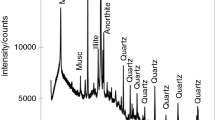Abstract
A Cameroonian kaolinite powder was treated with gliding arc plasma in order to increase the amount of hydroxyl functional groups present on its external surfaces. The functional changes that occurred were monitored by Fourier transform infrared spectroscopy. The crystalline changes were followed by the X-ray diffraction. The ionisation effect, acid effect, and water solubility of the treated samples were also evaluated. Results showed that there is breaking of the bonds in the Si–O–Si and Si–O–Al groups, followed by the formation of new aluminol (Al–OH) and silanol (Si–OH) groups at the external surface of kaolinite after exposing the clay to the gliding arc plasma. The increase in hydroxyl groups on the surface of kaolinite leads to the increase of its hydrophilicity. Moreover, new charges appear on its surfaces and no significant change in crystallinity has occurred. This study shows that clays in powder form being can effectively be functionalised by gliding arc plasma in spatial post discharge processing mode. Knowing that the treatment in spatial post discharge offers the possibility to process large amounts of clay, this work is of great interest to the industry.











Similar content being viewed by others
References
Yavuz O, Saka C (2013) Surface modification with cold plasma application on kaolin and its effects on the adsorption of methylene blue. Appl Clay Sci 85:96–102
Sahin O, Kaya M, Saka C (2015) Plasma-surface modification on bentonite clay to improve the performance of adsorption of methylene blue. Appl Clay Sci 116–117:46–53
Tonle I-K, Ngameni E, Njopwouo D, Carteret C, Walcarius A (2003) Functionalisation of natural smectite-type clays by grafting with organosilanes: physico chemical characterization and application to mercury (II) uptake. PhysChemChemPhys 5:4951–4961
Yavuz O, Altunkaynak Y, Guzel F (2004) Removal of copper, nickel, cobalt and manganese from aqueous solution by kaolinite. Water Res 37:948–952
Celini N (2004) Traitement des argiles par plasma froid pour leur utilisation comme charges de nanocomposite argile-polymère; Thèse de doctorat Ph.D soutenu en à l’Université du Maine Faculté des Sciences UMR CNRS 6120 Polymères, Colloïdes, Interfaces
Sigg J (1991) Les produits de terre cuite. Septima, Paris
Ciullo P-A (1996) Industrial minerals and their uses: a handbook and formulary. William Andrew Inc., New Jersey
Tanable K, Holderich W (1999) Industrial application of solid acid–base catalysts. Apply Catal A Gen 181:399–434
Braggs B, Ralston J, Smart RSC (2000) Surface modification of kaolinite. United States Patent no. 6,071,335
Ming H, Spark KM, Smart RSC (2001) Comparison of radios frequency plasma and ion beam induced surface modification of kaolinite. J Phys Chem B 105:3196–3203
Valdre G, Malferrari D, Marchetti D, Brigatti MF (2007) The effect, of different plasma gas environments on vermiculite layer. Appl Clay Sci 35:76–84
Djowe AT, Laminsi S, Njopwouo D, Acayanka E, Gaigneaux EM (2013) Surface modification of smectite clay induced by non-thermal gliding arc plasma at atmospheric pressure. Plasma Chem Plasma Process 33:707–723
Hnatiuc E (2002) Procédés électriques de mesure et de traitement des polluants. Tec & Doc, Paris
Brisset JL, Hnatiuc E (2012) Peroxynitrite: a re-examination of the chemical properties of non-thermal discharges burning in air over aqueous solutions. Plasma Chem Plasma Process 32:655–674
Burlicaa R, Kirkpatrickb MJ, Locke BR (2006) Formation of reactive species in gliding arc discharges with liquid water. J Electrostat 64:35–43
De Baerdemaeker F, Simek M, Clupek M, Lukes P, Leys C (2006) Hydrogen peroxide production in capillary underwater discharges. Czech J Phys 56:B1132–B1139
Lesueur H, Czernichowski A, Chapelle J (1988) A device for the formation of low temperature plasma by means of gliding electric discharges. French Patent no 2,639,172
Czernichowski A (2001) Glidarc assisted preparation of the synthesis gas from natural and waste hydrocarbons gases. Oil Gas Sci Technol-Rev IFP6:181–198
Njoya D, Elimbi A, Nkoumbou C, Njoya A, Njopwouo D, Lecompte G, Yvon J (2007) Contribution à l’étude physico-chimique et minéralogique des argiles de Mayouom (Cameroun). Ann Chim Sci Mater 32:55–68
Boudchicha MR (2010) Etude de la cristallisation et des propriétés mécaniques et diélectriques de céramiques préparés à partir de kaolin-dolomite. Thèse de Doctorat, Université El-HadjLakhder –BATNA (Algérie)
Socrates G (1994) Infrared characteristic group frequencies tables and charts. Wiley, New York
Marel H, Van Der W, Beutelspucher H (1976) Atlas of infrared spectroscopy of clay minerals and their admixtures. Elsevier, New York
Lazarev AN (1972) Vibrational spectra and structure of silicates. Consultant Bureau, New York (English Translation by G. D. Archard, V. C. Farmer)
Farmer VC (1974) The infrared spectra of minerals. Mineralogical Society, London
Russell JD, Fraser AR (1994) Clay mineralogy-spectroscopic and chemical determinative methods. Chapman & Hall, New York
Fanmoe J, Kamgang JO, Moussa D, Brisset JL (2003) Application De L’arc Glissant D’air Humide Au Traitement Des Solvants Industriels : Cas Du 1,1,1-Trichloroethane. Phys Chem News 14:1–4
Schoonheydt RA, Johnston CT (2006) Development in clay science (surface and interface chemistry of clay). In: Bergaya F, Theng BKG, Lagaly G (eds) Handbook of clay science. Elsevier, Amsterdam
Ming H, Spark KM (2003) Radio frequency plasma-induced hydrogen bonding on kaolinite. J Phys Chem B 107:694–702
Lapcik L, Lapcikova B, Krasny I, Kupska I, Greenwood W, Waters E (2012) Effect of low temperature air plasma treatment on wetting properties of kaolinite powders. Plasma Chem Plasma Process 32:845–858
Acknowledgments
The authors are grateful to Professor Jean-Louis Brisset of the Université de Rouen (France) for the plasma reactor support.
Author information
Authors and Affiliations
Corresponding author
Rights and permissions
About this article
Cite this article
Sop Tamo, B., Kamgang-Youbi, G., Acayanka, E. et al. Plasma Chemical Functionalisation of a Cameroonian Kaolinite Clay for a Greater Hydrophilicity. Plasma Chem Plasma Process 36, 1449–1469 (2016). https://doi.org/10.1007/s11090-016-9731-4
Received:
Accepted:
Published:
Issue Date:
DOI: https://doi.org/10.1007/s11090-016-9731-4




